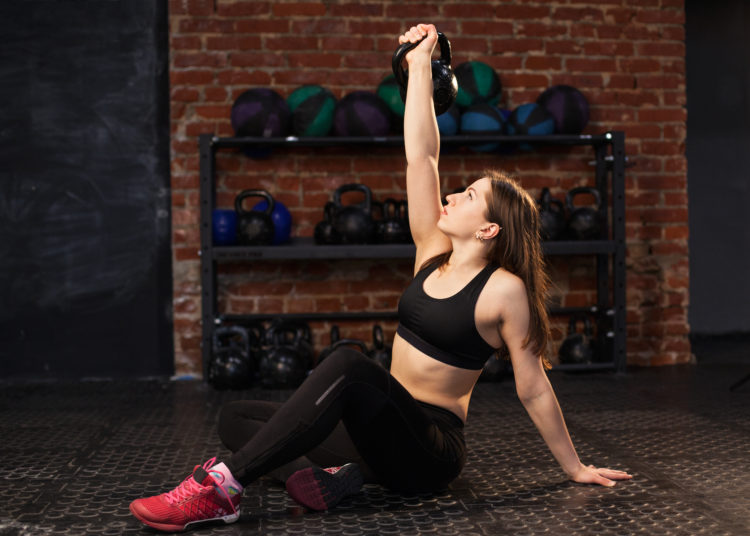One of the hardest things for a lot of strength athletes to do is slow down.
For many of us, the idea of not being able to lift can be legitimately inspire fear.
When I was a teenager, I had surgery on both my knees at the same time, and I tried to refuse the wheelchair they offered me in the recovery room. A few years ago, after my hand surgery, the only thing I wanted to know was when I would be able to lift again. With my top surgery coming up, the thing that scares me most is the weeks and weeks I’ll have to spend without touching a barbell.
Maybe it’s surgery, or an injury. Or maybe it’s socially isolating. Whatever it is that’s keeping you away from your beloved lifting platform, I feel you, hardcore. Because if the idea of being away from that sweet clanging of metal and the blessed squeeze of a solid hook grip is making your heart slam faster than a round of heavy sled pushes… well, you’re not alone. Even though you probably feel like you are.
Self-isolating at home because it is the right thing to do — of course it is. I’m healthy, but I can’t risk spreading it to people who are immunocompromised. For me, there will be home gymming, for sure, but I will also have to make some big emotional adjustments to cope with having no access to the equipment and social culture that get me up every day, that make me feel like I have a reason to live.
It’s pretty well-established that even though depression and anxiety can make it harder to start working out, once you do exercise (even just once), solid workouts can reduce your anxiety and help you combat depression.(1)(2)
If I’ve learned anything in the gym (and therapy) lately, it is — ironically — how to get through the depression and/or anxiety induced by not being able to work out. And the trick, for me, is mindfulness.
Editor’s note: The content on BarBend is meant to be informative in nature, but it should not be taken as medical advice. The opinions and articles on this site are not intended for use as diagnosis, prevention, and/or treatment of health problems. If you’re dealing with or exhibiting signs of depression, please seek the advice of a medical professional immediately.
Editor’s note: This article is an op-ed. The views expressed herein and in the video are the author’s and don’t necessarily reflect the views of BarBend. Claims, assertions, opinions, and quotes have been sourced exclusively by the author.

How I First Cultivated Mindfulness In The Gym
As an athlete with big emotions, I have spent many years abhorring the idea of stillness, of the type of mindfulness that makes me focus on that stillness, that silence. Perhaps ironically, barbells have taught me the immense value — the incredible power — of stillness and silence. I have learned, in the gym, to gain power instead of terror from letting myself be alone in my mind, which always seems to try and find new ways to make me hate myself.
So the gym has become my sanctuary. Not for yelling and grunting and getting pumped for a huge lift (I mean, sure, that too). But the gym has become my… quiet space. My calm, centered, meditative space. That calm, meditative bit has improved my lifting immensely.
Mindfulness is, in part, about ritual. Before I warm up, I adjust my headphones and kiss my wedding ring and engagement ring before securing them on my necklace. I take out my training log and write the date. I take out my shake and my Metcons. All of this is ritual. All of this is purposeful. Mindful. It centers my body so that I can push myself to do things I didn’t know I could yesterday, because my brain is integrated, ready. Prepared. Calm.

So I Get Calm When I Hit the Gym?
Well, yes and no. Because yes, you have to pump yourself up before a big attempt. There’s a reason ammonia is so popular before max lifts or colossal strongman efforts. But you need to be able to channel all your training, all your energy — and yes, all your pre workout and possibly ammonia — into precise, measured, beautiful technique. Cultivating a mindfulness practice will help you lift better, period. The more you train your mind to focus on the here and now, the better your mind-body connection will be. And the better your lifts will get.
Taking a few deep, quiet belly breaths before I pump myself up for a big set has also become ritual —I know where I stand, how my feet position themselves, when I close my eyes and when I stare at the loaded bar (just me and you, kid). And that stillness, that mindfulness, prepares me for big movement.
And the more present I am while I’m actually lifting, focusing on each muscle as it fires and each quick re-expansion of my lungs between reps, the more attuned I’ll be to my bar path, to where my lifts are going right and where they’re going wrong — and where they can get better next time.
These rituals of being present have become staples of my lifting practices. Now that I’m away from the gym for an indefinite period of time, I’m not sure how successful I’ll be at creating any kind of calm inside myself. But here’s how I’m trying.

You Can Move Your Mind Without Moving Your Body
Especially if you’re already prone to depression, the stress of anything from recovering from surgery to self-isolating can feel absolutely immobilizing. If you’re like me and the gym is your happy place — and now you can’t go to the gym — you can still create your calm, safe space. You may not have to actually put on pants (a definite plus side) and slip into your Metcons, but you can use the same mindfulness you use to improve your lifting to improve your life when you can’t toss weights around like you usually do.
If you’re like me and the gym is your happy place — and now you can’t go to the gym — you can still create your calm, safe space.
How? Even if you’re not able to get to your gym, use all your senses to summon up what it feels like.
The chill of the barbell knurls before anyone else has touched them in the morning; the scent of whatever disinfectant spray your gym uses (mine is super lemony). Combine all of that sensory information — even if you’re stuck in your living room — and let your eyes close. Let all your breath leave your body, just like you would before preparing to take a big brace. Focus on the weight you wish you had access to moving, the lift your muscles are aching to do. And, in your mind… do it. Go through step-by-step. Set your lats, squeeze your glutes. You can even go through the physical motions, sans barbell. Close your eyes and imagine it, go through it, breathe through it, move by move, rep by rep.
It won’t just make you feel more settled in the moment (sounds weird, I know, but once you practice, it’s actually super calming) — it could also make you a better lifter once you get back to the gym. In 2012, a study published in the Strength and Conditioning Journal found that using mental imagery to go through your lifts in detail can help you lift with better technique and confidence when you reunite with your beloved barbells.

Accepting My Reality
Because of course, that’s a huge fear in a lot of folks’ minds — even if you have a pull-up bar on your bedroom door and a kettlebell stashed away in case of emergency (this qualifies), you’re probably scared of losing your gains. And honestly? You might need to work back up to your maxes again, just like you do when you get back from a vacation that had nothing but a questionable hotel gym. But you won’t wither away. Honest. Sprints will help, some good old-fashioned YouTube kickboxing will help. So will yoga (talk about mindfulness!).
[Related: 6 things that happen to the body when you stop lifting]
But the biggest factor in keeping your body ready to get back in the gym is going to be how calm and supported you can keep yourself. When you’re freaking out about missing the gym, you might just not be able to get into the headspace for visualization, for the kinds of quiet calm that will help you keep your cool under a loaded barbell later. And that’s okay. Guided meditations, on apps and on YouTube, might be helpful. If they’re not? That’s okay, too.
Reach out for help. Reach out to vent. Let yourself lay on the living room floor and focus on nothing but the next breath. And then the breath after that. And the breath after that. Rep after rep after rep.
[Remember, you can work out at home. Here’s how to make fitness equipment from household items!]
More Tips to Combating Anxiety
Depression is horrible, and situational depression is so tough. Combine all that with anxiety and COVID-19-induced anxiousness, and you’ve got a real boss battle on your hands. You’re not the only one going through it — but you will make it to the other side. You will reunite with your barbells and your dumbbells and your lemony-fresh disinfectant for your post-bench press wipe downs.
In the meantime?
- Make a WhatsApp for your lifting friends, or for your friends you just like to share memes and fears with.
- Listen to fitness podcasts.
- Read fitness books.
- If thinking about fitness at all is making it worse, screw mindfulness and lose yourself in an epic high fantasy novel. Or watch Captain Marvel for the forty-second time.
All of these practices are extensions of mindfulness. You don’t have to be still and silent to be mindfully engaged in helping yourself cope with missing the gym. You are a valuable human being whether you’re lifting or not. Your life is worth living whether you’re lifting or not. Even if you can only lift in your mind for now, go crush some mental PRs: you got this.
Featured image via Mar Godoy/Shutterstock
References
- Lynette, L. et al. The Benefits of Exercise for the Clinically Depressed. Prim Care Companion J Clin Psychiatry. 2004; 6(3): 104–111.
- Harvey, S.B. et al. Exercise and the Prevention of Depression: Results of the HUNT Cohort Study. Am J Psychiatry. 2018 Jan 1;175(1):28-36.